The Federal Centre for expertise in Health Care (known as the “KCE”) considers that Automated External Defibrilation (termed “AED”) placed in a public place “enables in all likelihood to save anywhere between only 6 to 28 lives per year.”
It mentions this in a report published today. This somewhat moderate result may be explained by the relatively low number of cardiac arrest victims, who might benefit from the use of this device, the public who are ill-trained to intervene and even a lack of coordination in the distribution of current available devices.
Automated External Defibrilators are portable devices which can be connected up to the thorax of an individual in cardiac arrest. They can produce an electric shock if necessary. Around 9,000 Belgians have an inexpected cardiac arrest each year, of whom some 17 to 30% do so in a public place.
The KCE is responsible for assessing the efficiency and the cost-efficiency relationship of AEDs accessible to the public in Belgium. In the absence of precise figures for Belgium, researchers had to undertake a simulation based upon available international and Belgian results.
It emerges that the impact of the AED on overall deaths through cardiac arrest is limited. Increasing the number of devices, without any form of coordination, whilst neglecting other stages in the survival chain – recognising the problem early, calling the emergency services immediately, early resuscitation and care received from the emergency services - is ineffective.
Moreover, the public are ill-trained to intervene. The location of devices is also a difficulty. This is becuse they are not found close to or in private buildings, and as there is no mapping of their location. If, in theory each owner were to register their device with the FPS Public Health the complexity of this would be daunting.
Moreover, a maximum of 8% of victims of a cardiac arrest can actually benefit from defibrilation by passers-by. Less than a fifth (17%) of arrests happen in a public place in Belgium, 44% of which are in the presence of witnesses. In addition, 20% of arrests do not have a cardiac nature. These do not necessitate an electric shock. Above all, once the AED is ready to use it is sometimes too late.
The KCE is firstly recommending that the various stages of the survival chain are optimised by notably improving the skills of the general public in this area. It suggests information campaigns and compulsory training in business and at secondary school. It also proposes that new approaches be tested, such as the training of volunteers who can be immediately located and mobilised by the emergency services.
The Brussels Times

